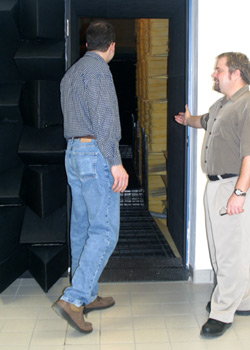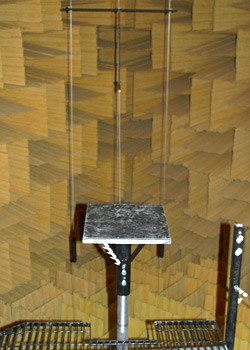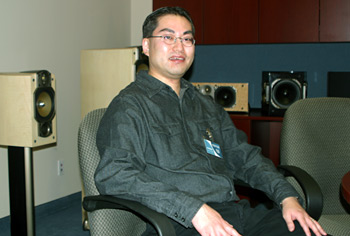![[SoundStage!]](../sslogo3.gif) The Traveler The TravelerBack Issue Article |
||
March 2003 Paradigm's Renovation: Part Two
In January, I told you about Paradigm's new manufacturing facilities. While the company's ability to build loudspeakers and electronics is impressive, the design work is every built the equal -- and this is even more interesting to audiophiles like myself and our writing team. Along with the consolidation of manufacturing operations, Paradigm has also brought its speaker-design team into its new and expanded building. The design team has an even better facility than the old one -- state-of-the-art-er, I guess. And it’s all the more fascinating when you consider where the Canadian loudspeaker industry was in 1980, about the time that Paradigm Loudspeakers began. I was a budding audiophile in the early 1980s -- still in high school and bugging the local salesmen at the audio shops in Regina, Saskatchewan. I was certainly nowhere near being in the industry. But I have heard the history of the Canadian speaker industry many times, and then some, so I know that back in the early ‘80s none of the Canadian mega-speaker-companies had its own anechoic chamber or any real test equipment. In fact, it was Canada’s National Research Council along with its facilities and the research work of Dr. Floyd Toole that helped to make everything happen. Toole’s research became the launching pad for future Canadian-based speaker designs, and the impressive NRC facilities -- particularly the anechoic chamber -- became "standard equipment" for Canadian speaker designers. Paradigm continued to use the NRC's facilities for some time; a number of the other Canadian speaker companies did the same (some still do). But being the kind of company that has seemingly everything in-house, it’s not surprising that Paradigm was one of the first to build its own anechoic chamber -- and they’ve continued to improve on it since. So, obviously, the heart of Paradigm’s design area is the new anechoic chamber. It’s HUGE, some 33,000 cubic feet. If that sounds like a lot of space, it is. It’s the largest anechoic chamber I’ve seen. The fiberglass-based wedges (17 truckloads worth!) on the walls are about six feet long, and each wedge has another two feet or so beyond the angled part to ensure any reflections are gone, gone, gone. And as with any well-designed anechoic chamber, the walls here are isolated from the rest of the building -- it's more or less a building in a building and held with springs off the main building’s floor. Walk into the chamber and you’ll find it eerily quiet and, of course, reflection-free. There’s a single-point microphone strung in the center, and there’s a small platform for holding the loudspeaker. This all seems simple, but the investment needed to construct it all is staggering. It’s one of those "if you have to ask you can’t afford it" sort of things. It’s not surprising, then, that few companies in the world have the equal of what Paradigm has. And this chamber is the front-end, so to speak, to the design horsepower behind it. Much of the speaker-design work at Paradigm is now done on computer by team of engineers. They can take a "raw" loudspeaker, do a complete set of measurements (over 360-degree space in the chamber of course), dump all that data in their computer systems, and then with propriety software precisely model the loudspeaker’s crossover network and resulting acoustic performance with astonishing accuracy. The design team put on a little demo for us to illustrate how many combinations of crossovers could be simulated in, quite literally, minutes. Scott Bagby heads the engineering side of the firm. When I saw one of his designers whizzing through crossover after crossover, I turned to him and said, "It would take a designer with traditional tools six months to try this many combinations." He responded, "Oh no, they would never have enough time in the world to try this many crossover combinations!" And smiling quietly as we marveled at the speaker software demo was Dr. Peter Schuck -- formerly with Canada’s National Research Council. Schuck’s been with Paradigm for many years now, and his handiwork is sprinkled throughout. Among many things, Schuck’s an expert in mathematics and digital signal processing. The proprietary software I mentioned was written by him. But this isn’t to say that Paradigm puts all the data in a computer, cranks a speaker design out the other side, and slides it all down the assembly line to the warehouse. Even with all this equipment, a loudspeaker isn’t finalized until it passes critical subjective listening tests. When a design reaches a crucial stage, the designers, and likely some others too, are put into in a blind listening room with the new offspring and they listen to it. If a product doesn’t pass there, then no matter what the measurements say, it goes back in the design loop. And it’s no doubt that this level of sophistication has paid off for Paradigm. The scope of their product range is staggering, from speakers priced less than $200 per pair to a new line in their Paradigm Reference series called Signature. Bagby calls the Signature speakers an "all-out engineering effort" -- a claim you don’t take lightly when you see these products. Signature is meant to challenge the state of the art in speaker design -- even if Paradigm’s speakers don’t cost anywhere near what some competitors’ products do. And, obviously, the pricing has been creating a lot of buzz and anticipation in the marketplace. Paradigm proudly rolled out their pre-production Signature series speakers, and like most speakers from this company, they look like they should cost a whole lot more than they do. With sculpted cabinets, exquisite woodwork, and brand-new drivers and crossovers, they’re impressive-looking to say the least. Unfortunately, we couldn’t hear them. However, Bagby and crew spilled plenty of details.
There will be three main speakers in the Signature line: the S2, S4, and S6, with retail prices projected to be $2000 USD, $4000, and $6000 per pair, respectively. The S2 will be a two-way bookshelf speaker. The S4 is a tall stand-mounted speaker similar in ways to the company’s Active/40 and Studio/40 speakers -- a single tweeter and dual woofers in more than likely a two-and-a-half or three-way configuration. The S6 will be a tall floorstanding speaker with one tweeter, one midrange, and multiple woofers. There will be two center-channel speakers called the Signature C3 and C5, priced at $2500 and $4000 each, respectively. Only one set of surrounds will be available, called Signature ADP, and it will sell for $2500 per pair. There will also be a Signature subwoofer priced at about $3000. And while that may seem expensive to some, remember that this is Paradigm’s top-of-the-line offering. Complementing Paradigm’s Signature series is sister-company Anthem’s new Statement line of electronics. The Anthem products are the ones not designed in this new facility; they're designed at Paradigm’s Advanced Research Center (PARC) in Ottawa. Given that I live in Ottawa, I may well make the trip the PARC soon. Anthem products are built in this factory, however, and the new Statement products include the P2 and P5 amplifiers, and D1 surround-sound processor. The Statement amps will cost a kilobuck per 325W amplifier channel. So the P2 two-channel amplifier will be $2000; the P5 will obviously have five amplifier channels and will cost $5000. The D1 can be thought of as an AVM 20 -- one of the most popular high-end surround-sound processors on the market and winner of Home Theater & Sound’s Product of the Year for 2002 -- taken to the next level. The designers took the basic platform of the AVM 20 and then tried to improve every aspect of its performance. The D1 is projected to retail for $6000. What defines Paradigm and Anthem is a combination of performance and price. In a nutshell, their products are cutting-edge and affordable. And I can imagine there’s going to be a line for the new products, but you don’t have to wait much longer. The company is targeting having Paradigm Signature speakers and Anthem Statement electronics on dealers’ shelves by the midpoint of 2003 -- and no doubt the newly expanded manufacturing plant is going to come in handy for the rollout. ...Doug Schneider If you want to find out more about Paradigm and Anthem products, visit their websites at paradigm.com and anthemav.com.
|
||
|
||
![[SoundStage!]](../sslogo3.gif) All Contents All ContentsCopyright © 2003 SoundStage! All Rights Reserved |


